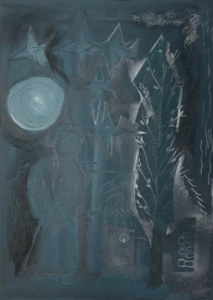Did you know that national Moon Day is celebrated this week?
It was on July 20th, 53 years ago that man first set foot on the moon. This landing, as well as the Space Race that followed, are recognized as one of the greatest human technological achievements.
But long before these 20th century events, the moon held an important role across all societies and cultures.
The curiosity of its consistent presence, the simplicity and sequence of it’s form, the reassurance found in its reflection of the passage of time. It has inspired curiosity and creativity for thousands of years— the subject of music, myth and visual art for all of recorded human history.
Just a short walk through the permanent collections of our small museum is a testament to the influence of this orb on the visual arts. There are dozens of works just in our collection which reference lunar imagery. And in honor of this remembrance day, I thought I’d share a few of my favorites:
“Moon Ring 3” is a sculpture that seems to welcome visitors to our museum. It was sculpted by Jesus Bautista Moroles in 1982, and stands near a fountain at our front facade. Carved from Texas Pink Granite, it reflects three vertically stacked, moon-shaped holes. Though a symbolic and abstracted work, it easily reminds of the phases and passage of time. (It’s also a selfie favorite with visitors as each moon seems perfectly “face-sized.”)
My favorite moon of the collection might be “The Night is Down Upon Us” by Veronica Helfenstellar. It is a mixed media painting of a cozy, nocturnal scene. In the foreground we find a small cottage with a candle burning in its doorway, and a tree with branches reaching towards the heavens. A woman stands alone at lower left. The muted tones and soft lines of the work give a cozy and dreamy vibe that appeals to me.
“February 28th, 1877 #7” by Jeffery Brosk might reflect the moon most connected to our museum. Though its form and size feel sculptural, the work is a bold painting of black stain and gold leaf on cherry wood. The artist used local historical records to paint the moon from the perspective of a prisoner housed in our original jail building. Through this work we are transported back to the night of February 28th, 1877, as a golden moon shines through the dark, narrow windows of its upstairs cells. (Now a contemporary gallery space.) Understanding that context certainly adds to the power of its visual contrast.
Perhaps the most recognized moon of our collection is “The Path Into the Blue” by Paul Klee. This oil and encaustic depicts a nocturnal landscape and moonlit path. It seems to show a new, rather than full moon, and reflects a more emotional than realistic rendering of the subject. The simple abstraction of the scene as well as its deep, cool tones inspire a feeling of peace and solitude.
The are only a few of the many celestial views waiting for you in our collection!
So, in celebration of Moon Day and these long, summer nights, I hope you’ll visit our many moons in person soon, or explore via our online catalog.
Kellie Bellah
Visitor Services Associate




